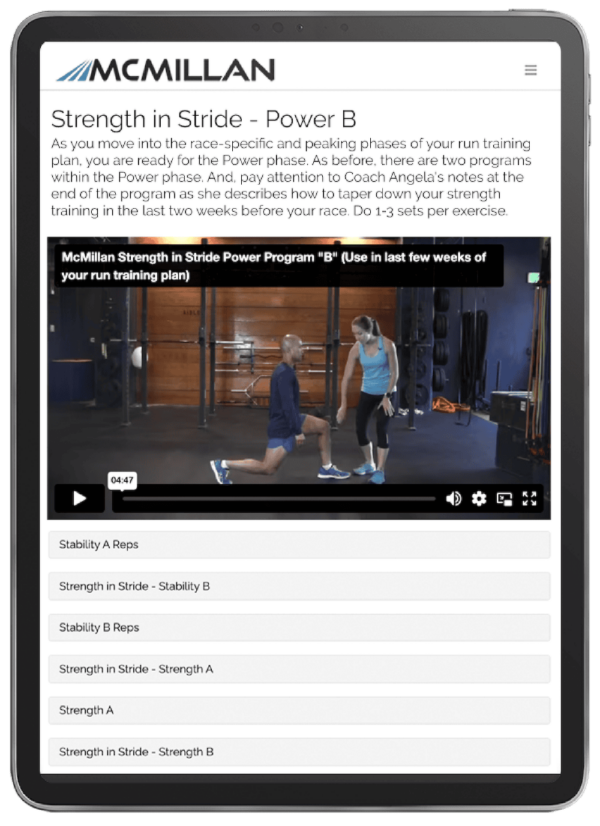Quick Fix Running Injury Protocol
Over the years, I developed a protocol for when an ache or pain pops up. Nearly 100% of the time, this protocol allows the body to heal and keeps tightness/aches/pain from advancing into a training cycle killing injury.
Please note that a critical component is that you recognize, admit, and immediately take action. If you feel something is not right but ignore it (like too many runners do), you risk a full-blown injury.
Fast action like the protocol below is a big reason why McMillan runners rarely get hurt.
Quick Fix for Injuries Protocol for ALL Runners
When you feel something, do the following:
1) Take a day off (no exercise) – Your body is clearly telling you that it needs more recovery so give it some.
2) After a day off to let your body recover, go back to your training plan BUT, for two to three days reduce the training load by 50 to 100 percent and only do easy runs – no long runs or hard workouts. This means that if you normally have easy runs of 30-45 minutes in your plan, you take the day off or run 15-20 minutes easy.
Again, the body is saying it needs more recovery so give it more. In total, this protocol means you’ll have three to four days of reduced training. That usually does the trick and you can ease back to your full training load over a few days.
Care Plan
BUT the training adjustment goes beyond the training plan. You must do the following during this three to four day period.
1) See a therapist ASAP. Seeing a therapist regularly is a must not just so you avoid injuries but for when something out of the ordinary pops up. A therapist you see regularly is more open to squeezing you in when something comes up that you feel could risk and injury.
2) Do a lot of self-care. You absolutely must:
Take at least one ice bath each day for 4-7 days
Rest! Ramp up rest. The extra time in your day from not running as much should be used to lay down and rest. Plus, focus on getting to bed early and lowering life stress so you maximize recovery.
Begin gentle active isolated mobility. As tightness and pain subsides, your body likes gentle active isolated mobility to increase blood flow and calm the nervous system. It’s important to note that this is not hard core stretching. This is gentle movements that help the healing process. More on mobility here.
Self-massage. From foam rolling to massage guns, any gentle massage that feels good can help healing.
Anti-inflammatory diet. Do a google search for anti-inflammatory diets. Just like ant-inflammatory drugs, this diet helps reduce inflammation.
Mental De-stress + Laughter. As much as possible, reduce your life stress during this protocol. Push meetings and other commitments so you have more time to rest and recover. And during this extra rest, watch a lot of videos, programs and/or movies that make you laugh. Turns out laughter is indeed great medicine.
Hydrate. Our tissues are bathed in fluid and work better when optimally hydrated. During this protocol focus on getting and staying well hydrated.
Cross-training. Yes. You can cross-train during this protocol (except for the first day) BUT the cross-training must be low stress and does not aggravate the affected body part. In other words, don’t jump into a spin class and do an hour of high intensity exercise. Instead, choose to just ride with low resistance. Swimming, aqua jogging, elliptical, gentle yoga and even a slow walk are great ways to help with healing and occupy your mind if you are freaking out about missing training.
Here is more on how to accelerate recovery.
Returning to Training
If all feels good after the 2-4 days of reduced training, move to 25-50% reduction in training load for 2-3 days. Again, avoid hard/long runs. Just run easy but shorter than your usual easy run.
NOTE: If the tightness/ache/pain is in an area that frequently get injured, consider 1-2 more days of the 25-50% reduction before you return to your training plan.
After 2-3 days of lower volume, return to full training. BUT run lowest volume, slowest pace in your plan. This is exactly why I build plans with a range of volume and pace. Choose the lowest/shortest distance and run at the slow end of the pace race. Also, be very careful when you do your first hard workout or long run after the quick fix protocol. Again, do the lowest volume and the slowest end of the pace range.
Final Thoughts
Runners who quickly detect and adjust training never get a training cycle killing injury. It can be hard mentally to miss training but trust me, a few days of reduced training will not ruin your training cycle. But, weeks or months off with an injury will. Listen to your body and use this protocol the next time you feel tightness/aches/pains.
Quick Fix Running Injury Protocol Frequently Asked Questions
The main goal of this protocol is to address any aches or pains promptly to prevent them from developing into more serious running injuries.
If you experience discomfort during training, the first step is to take a complete day off from exercise to allow your body to recover.
Following a day of rest, reduce your training load by 50 to 100 percent for the next two to three days. Focus on easy runs and avoid long runs or hard workouts during this period.
Besides adjusting your training, it’s crucial to see a therapist, take ice baths, prioritize rest, engage in gentle active isolated mobility exercises, practice self-massage, follow an anti-inflammatory diet, reduce stress, hydrate, and consider low-stress cross-training.
After the initial 2-4 days of reduced training and if you feel better, gradually return to training by reducing the volume by 25-50% for 2-3 days. When resuming full training, start with the lowest volume and the slowest pace in your plan. Be cautious when reintroducing hard workouts or long runs, opting for lower volume and slower paces initially.
SPECIAL OFFER
For a limited time, I’m offering a 14-day free trial of McMillan Training. Take a plan for a spin. Kick the tires as they say. If you like it, do nothing and your subscription will start. If you don’t like it, just cancel and you owe nothing. It’s a great way to experience training on what has been called, “The best training system on the planet.”














